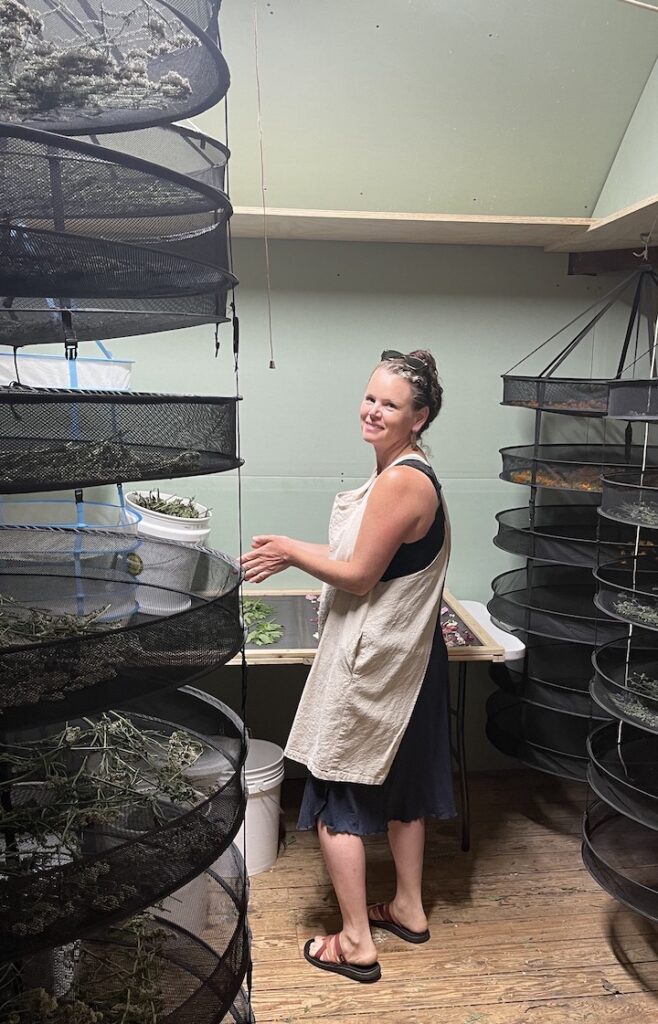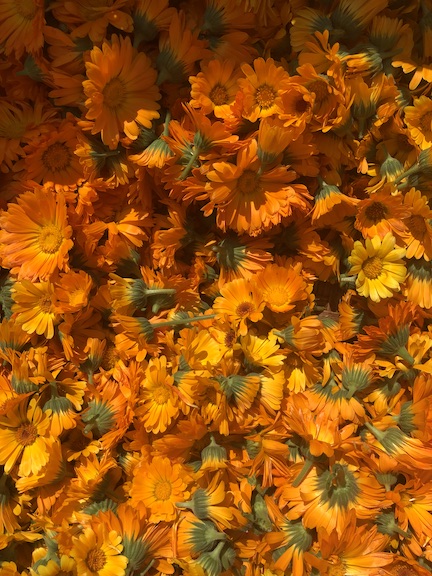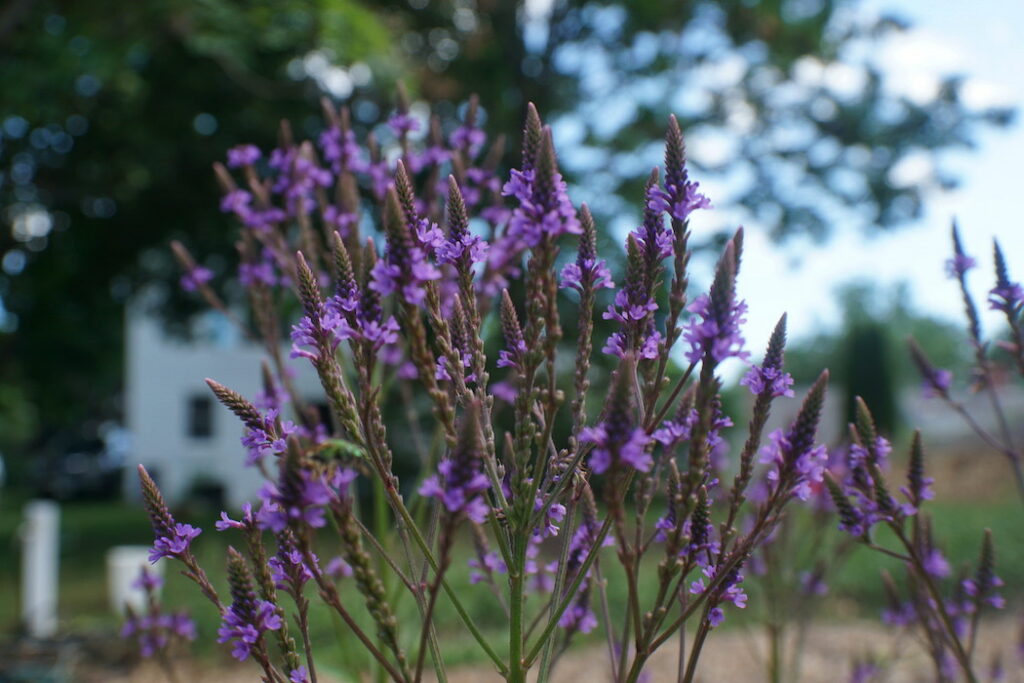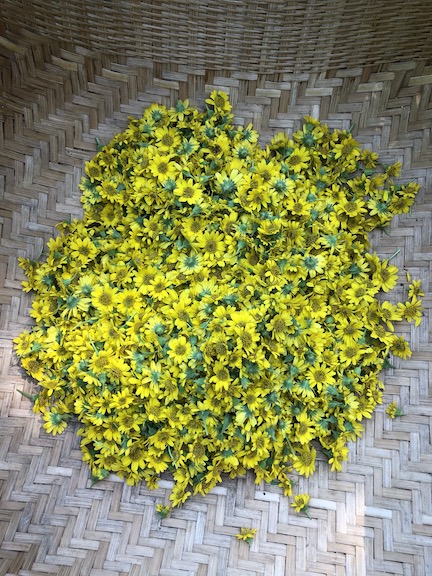Bringing More Organic Herbs, and Herb Growers, to Maine
By Sonja Heyck-Merlin
The 25 members of the Meeting House herb growers collaborative talk enticingly about their plant medicines: whether it’s the sticky, resinous calendula buds or the tufts of crimson bee balm flowers reminiscent of an ‘80s rockstar hairdo. They’re equally passionate about the unassuming yarrow and red clover blossoms, and they wax poetic about their subterranean and slow-growing echinacea and ashwagandha roots. Each of these medicinal plants, and there are hundreds more which can be cultivated in Maine, demonstrate a unique beauty and healing power.
The collaborative, founded by Emily Springer in 2017, believes that their spirit of cooperation will empower more people to make and grow local medicine for their communities. Currently, the members grow, dry and distribute about 80 medicinal plants. It is not required that growers be certified organic to join, but the goal is that they will work toward certification.

Springer didn’t intend to start an herbal medicine collaborative. Like the inception of many businesses, the idea stemmed from a simple personal problem — a lack of supply of local, organic herbs for her family’s herbal medicines. Springer was interested in simple things like salves, tisanes (tea mixes) and tinctures. When she bought some elderberry flowers to make elderberry syrup, she was surprised to see that they came from Eastern Europe. “Wait a minute,” she recalls. “I am ordering elderberry flower, which grows in abundance in Maine, and I am getting it from Bulgaria. We need to grow this here and dry it.”
Springer stepped away from a 20-year career in finance, and she and her husband and twin boys purchased 2 1/2 acres of a historic farm in Scarborough and began cultivating and selling medicinal herbs. They called it Meeting House Farm, which eventually inspired the name of the collaborative. By the second year, she realized that the demand for her products far exceeded her supply capacity. According to Springer, the global medicinal herb market is $83 billion a year, with the majority of herbs coming from large farms in Europe and Asia.
“When you farm at such a large scale, the quality degrades,” she says. “I decided we should bring together lots of small farms where we can still farm by hand and have super high-quality medicinal herbs in a market that is just growing and growing. We can supply the Northeast, all the while we’re healing the Earth while meeting this market.”
Springer still grows 1 ½ acres of medicinal herbs in a no-till system for the collaborative, although she says she spends about 75% of her time managing the business. To compensate for her time away from the gardens, she developed a work-trade program managed by a full-time employee. Each week, 18 different people come to the farm and work a two-hour shift, mostly cultivating and harvesting, in exchange for knowledge and herbs. Springer makes it clear that the farm calls it “cultivating” and not “weeding” because every plant has a purpose.
Another of the collaborative’s growers is Patch Farm, located in Denmark in Maine’s western lakes region. On 20 acres of open land, BrennaMae Thomas-Googins and her family raise certified organic vegetables, livestock and a diverse array of culinary and medicinal herbs. The medicinal herbs were mostly grown for the farm family until a fortuitous meeting between Thomas-Googins and Springer at a biodynamic workshop at Avena Botanicals (Avena is also a member of the collaborative.) According to Thomas-Googins, the opportunity to sell herbs through the collaborative gave her the incentive to start treating them as a commercial crop.

“It was a great way to help us decide that we could dedicate more time to growing bigger quantities of herbs that speak to us,” says Thomas-Googins. She says, for example, that because of this wonderful market, she’s able to justify to her employees picking red clover flowers for four hours. Patch Farm also sells arnica flowers and ashwagandha, burdock, echinacea and astragalus roots to the collaborative.
Each grower is responsible for setting up a drying facility, a critical part of providing high-quality herbs, on their farm. Because of Maine’s humidity, drying herbs is often the most difficult part of the process. According to Springer, the drying room should be kept at about 80 degrees Fahrenheit with humidity levels of 30% or less. Some growers suggest using a high tunnel or greenhouse with a shade cloth, but Springer believes darkness is key to preserving the color and medicinal properties of the plants.
Avoiding cross contamination is another important part of the drying process. Springer, who dries herbs in what once was a carriage house, can slide a piece of plywood between each 4-by-4-foot drying rack to prevent each drying herb from dropping debris onto the herbs below it.
Patch Farm dedicates a room of the farmhouse to drying. They use a basic system of stacked mesh racks with a few fans to help circulate the hot air rising into the clean upstairs room.
Another collective member, Wild Few Herb Farm, converted a 40-foot shipping container into a drying facility. Nicole Heker and Zoë Shwidock of Wild Few are in their first year of growing herbs on a ½ acre of leased land in Arundel. (Shwidock also works as an apprentice at Meeting House Farm one day per week.) The pair hopes the annual herbs they dry this year — tulsi, calendula, chamomile and milky oats — will support them until they begin harvesting perennials like lemon balm, anise hyssop, skullcap, yarrow, elecampane and echinacea.
Once a month, Springer drives around the state to exchange clean, empty food-grade buckets with ones filled with colorful, aromatic dried herbs. For now, she uses her experience and senses to judge the quality of each product but looks forward to testing the herbs for potency. She points out that there are many Maine labs testing cannabis but none for medicinal herbs.

Blue vervain. Hailey Springer photo
From there, she takes over the storage, processing, marketing and distribution of the herbs.
“We’re trying to make this really easy for the farms. We do the marketing, social media and e-commerce platform. We try to highlight each individual farm, not white labeling — which is what other companies do,” Springer says. To make the process even easier on the farms, she dreams of establishing a collective drying and processing facility in a more centralized location, perhaps in the Richmond or Bowdoinham area.
There are two models for payment to the farms: upfront purchase and consignment. With established growers, the first option is typically exercised because Springer knows they can deliver a quality product. For new growers, Springer prefers the consignment option, in which the grower and the collaborative split a percentage. For example, Springer will pick up 2 pounds of echinacea, and the farm will get the majority of the consignment based on how much sells. Springer also likes the consignment option when she is trying out a new herb, something like toadflax that she’s uncertain about how well it will sell.
Retail sales — to small stores and through online purchases — make up about 60% of the collaborative’s sales. The remaining sales are to the Blue Hill, Portland and Belfast co-ops. In March, customers can pre-order herbs, with the minimum order being 1 pound per product. “This helps us plan,” Springer says. “If we have 30 pounds of nettles pre-ordered, I can tell everyone to please harvest nettle.” The price paid to the growers is dictated by the global market; Springer sets prices by calculating the average prices of five of the United States’ larger herb companies, such as Frontier Co-Op and Mountain Rose Herbs.
As a certified organic processor, Meeting House Farm creates additional products made with the collaborative’s herbs, including tinctures and herbal-infused oils. The oils are made with a base of organic jojoba extract infused with dried plants for eight days at 80 degrees to preserve potency of the plant constituents. Custom blends of tinctures and oils are also available.
In 2022, some farms are adding dye plants, like indigo and coreopsis, to sell to the collaborative. “Dye plants pair nicely with medicinal herbs,” says Heker. “They also deepen our appreciation of plants.”
At this point, Springer sees selling medicinal herbs or dye plants to the collaborative as revenue diversity for a farm rather than a primary income stream. Organic vegetable farms or orchards, for example, might add some medicinal herbs to their crop plan. The intangible benefits of growing these plants — increasing biodiversity, nurturing pollinators and building soil — also happen to be the foundations of organic agriculture.
Springer cites oats as a perfect example: “A vegetable farm cover crops with oats. Then, they can harvest the milky oat tops in July, dry them, and sell them for $36 per pound. Oats in particular build the soil. So, you have a crop which benefited the soil, added a revenue stream and created a local, medicinal herb crop.”

At Patch Farm, Thomas-Googins appreciates that Meeting House is allowing their farm business to grow without increasing their vegetable and livestock enterprises. And rather than diversify by increasing the species of medicine she grows, Thomas-Googins is excited to produce larger quantities of herbs that she is already growing. “How darling would it be to say I harvested 30 pounds of arnica?” says Thomas-Googins.
With an increase in production, she also hopes to donate some of the farm’s medicine to underserved and disadvantaged communities. Thomas-Googins feels a sense of responsibility to get medicinal herbs into the hands of anyone who needs them. “It’s a way to pay it forward and do some reparations work. So much of this knowledge has been acquired from different communities and cultures,” she says.
Although the collective’s growers span the state, from Machias to Kennebunk, their values are simple — to make the world a better place for all living things by nurturing plants. Plants that can make their farms more beautiful and resilient, that can compel a symphony of pollinators into their fields and that can then be used as medicine: something as simple as a cup of steaming fresh chamomile tea to ease away the stress of a day.
“Meeting House allows us to come together and accomplish things that we could not do as individuals. Now we can see our medicine in places where we wouldn’t otherwise. It inspires us all the time,” Heker and Shwidock say. Thomas-Googins adds, “Maine herbalists using Maine herbs to heal Mainers is super exciting.”
About the author: Sonja Heyck-Merlin is a regular feature writer for The MOF&G. She and her family own and operate an organic farm in Charleston, Maine.
This article was originally published in the fall 2022 issue of The Maine Organic Farmer & Gardener.

